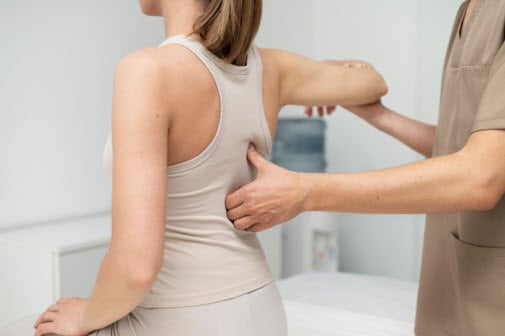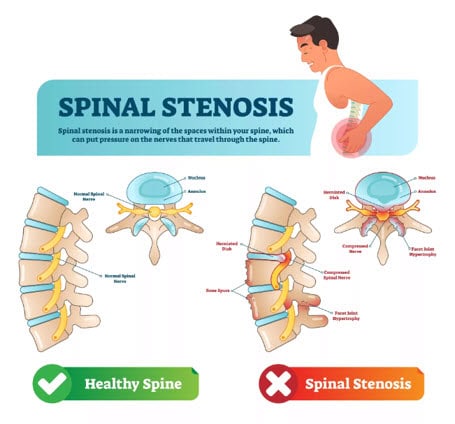
Spinal Stenosis: Understanding the Narrowing of the Spinal Canal
Spinal stenosis is a medical condition that affects the spinal canal, causing it to narrow and put pressure on the nerves and spinal cord. This narrowing can occur in various parts of the spine, including the neck (cervical stenosis) or the lower back (lumbar stenosis). As the spinal canal narrows, it can lead to a range of symptoms and discomfort.
Spinal stenosis is often a result of degenerative changes in the spine, such as the gradual wear and tear that occurs with aging. It can also be caused by conditions such as herniated discs, bone spurs, or thickened ligaments. The narrowing of the spinal canal can lead to compression of the nerves, resulting in pain, numbness, and weakness.
Understanding the symptoms and different stages of spinal stenosis is crucial in identifying and managing this condition effectively. By recognizing the typical causes and risk factors, individuals can take proactive steps to prevent and alleviate the symptoms associated with spinal stenosis.
Symptoms & Different Stages of Spinal Stenosis
Spinal stenosis is a medical condition that primarily affects the spine, causing a narrowing of the spinal canal. As a result, this narrowing puts pressure on the nerves and spinal cord, leading to a range of symptoms. The severity of these symptoms can vary depending on the stage of the condition.
- Stage 1: In the early stages of spinal stenosis, individuals may experience mild symptoms that are often overlooked or attributed to normal aging. These symptoms may include occasional back pain, numbness, or tingling in the legs, and mild weakness.
- Stage 2: As the condition progresses, the symptoms become more noticeable and may occur more frequently. Patients may experience persistent pain in the lower back, buttocks, or thighs. Numbness and weakness in the legs may also become more pronounced, making it difficult to walk or stand for extended periods.
- Stage 3: At this advanced stage, the symptoms of spinal stenosis can significantly impact an individual’s daily life. Chronic pain in the back, buttocks, and legs may be constant and severe. Walking or standing for even short distances can become extremely challenging, leading to limited mobility. Numbness and weakness may also worsen, affecting coordination and balance.
It is important to note that the progression of spinal stenosis can vary from person to person. Some individuals may experience a rapid deterioration of symptoms, while others may have a slower progression over time.
If you suspect you may have spinal stenosis, it is essential to pay attention to the severity and frequency of your symptoms. While mild symptoms may be managed with self-care techniques, more severe or worsening symptoms should prompt a visit to a healthcare professional. Seeking medical attention is particularly crucial if you experience difficulty controlling your bladder or bowel movements, as this may indicate a more serious underlying condition that requires immediate attention.

Most Common Causes of Spinal Stenosis
Spinal stenosis is a condition that occurs when the spinal canal narrows, putting pressure on the nerves and spinal cord. This narrowing can be caused by a variety of factors, including:
- Age-related degeneration: As we age, the discs in our spine can start to wear down and lose their ability to cushion the vertebrae. This can lead to the narrowing of the spinal canal.
- Arthritis: Osteoarthritis and rheumatoid arthritis can both contribute to the development of spinal stenosis. Inflammation and the formation of bone spurs can cause the spinal canal to narrow.
- Spinal injuries: Trauma to the spine, such as fractures or dislocations, can result in spinal stenosis. These injuries can cause the vertebrae to shift and compress the spinal canal.
- Herniated discs: When the soft inner material of a disc pushes out through a tear in the outer layer, it can put pressure on the spinal canal and lead to stenosis.
- Thickened ligaments: Ligaments in the spine can become thickened and stiff over time, causing them to bulge into the spinal canal and narrow the space available for the nerves.
It is important to note that these are the most common causes of spinal stenosis, but other factors may contribute to the development of the condition. It is always best to consult with a healthcare professional for an accurate diagnosis and appropriate treatment with the dry needling plan.
How bad can Spinal Stenosis get if left untreated?
- Increased pain and discomfort: As Spinal Stenosis progresses, the narrowing of the spinal canal can lead to increased pressure on the nerves and spinal cord. This can result in persistent pain and discomfort in the affected area.
- Decreased mobility: The narrowing of the spinal canal can also restrict the movement of the spinal cord and nerves, leading to a decrease in mobility. This can make it difficult for individuals to perform daily activities and may even require the use of assistive devices such as canes or walkers.
- Nerve damage: If left untreated, Spinal Stenosis can potentially lead to permanent nerve damage. The compression of the nerves can cause symptoms such as numbness, tingling, and weakness in the affected area. Over time, this can result in loss of sensation and muscle function.
- Loss of bladder or bowel control: In severe cases, Spinal Stenosis can lead to a condition known as cauda equina syndrome. This is a medical emergency characterized by the compression of the nerves at the lower end of the spinal cord. Symptoms may include difficulty urinating or having a bowel movement, as well as numbness or weakness in the legs.
- Impaired quality of life: As the condition progresses, individuals may experience a significant decline in their overall quality of life. Chronic pain, limited mobility, and other symptoms can make it challenging to engage in daily activities, leading to feelings of frustration, isolation, and depression.
Chiropractic for Spinal Stenosis
Chiropractic care offers a holistic approach to managing spinal stenosis, focusing on reducing pain, improving mobility, and enhancing overall quality of life. Chiropractors are highly trained professionals who specialize in diagnosing and treating conditions related to the musculoskeletal system, including spinal stenosis.
Here are some ways chiropractic care can help individuals with spinal stenosis:
- Spinal adjustments: Chiropractors use gentle spinal adjustments to realign the vertebrae and reduce pressure on the spinal nerves. These adjustments can help alleviate pain, restore proper spinal function, and improve mobility.
- Stretching and strengthening exercises: Chiropractors may recommend specific exercises to stretch and strengthen the muscles surrounding the spine. These exercises can help improve flexibility, stabilize the spine, and support proper posture.
- Posture correction: Poor posture can exacerbate the symptoms of spinal stenosis. Chiropractors can provide guidance on proper posture and offer strategies to correct postural imbalances. This can help relieve pain and prevent further deterioration of the spine.
- Soft tissue therapy: Chiropractors may use various soft tissue techniques, such as massage or trigger point therapy, to reduce muscle tension and improve circulation in the affected area. This can help alleviate pain and promote healing.
- Lifestyle modifications: Chiropractors can provide guidance on lifestyle modifications, such as ergonomic adjustments at work or home, that can help individuals with spinal stenosis manage their condition more effectively.
It is important to note that chiropractic care for spinal stenosis should be personalized to each individual’s specific needs and condition severity. A thorough evaluation and assessment by a qualified chiropractor will help determine the most appropriate treatment plan.

Self-Help & Relief for Spinal Stenosis
- Exercise regularly: Engaging in low-impact exercises such as walking or swimming can help strengthen the muscles around the spine and improve flexibility. These exercises also promote blood flow to the affected area, reducing inflammation and pain.
- Practice good posture: Maintaining proper posture while sitting, standing, and walking can alleviate pressure on the spine and provide relief from spinal stenosis symptoms. Avoid slouching or hunching forward, and make sure to use ergonomic furniture and supports when necessary.
- Apply heat or cold therapy: Alternating between hot and cold packs can help reduce inflammation and numb the affected area, providing temporary relief from pain and discomfort. Apply a heating pad or warm towel for 15-20 minutes, followed by an ice pack for the same duration.
- Use assistive devices: Depending on the severity of spinal stenosis, using assistive devices such as braces, canes, or walkers can provide support and stability while walking or performing daily activities. These devices help reduce strain on the spine and alleviate pain.
- Practice gentle stretching: Incorporating gentle stretching exercises into your daily routine can help improve flexibility and relieve muscle tension associated with spinal stenosis. Consult a chiropractor or physical therapist to learn specific stretches targeting the affected area.
- Manage weight: Maintaining a healthy weight is crucial for managing spinal stenosis symptoms. Excess weight puts additional pressure on the spine, worsening the condition. Adopting a balanced diet and engaging in regular physical activity can help achieve and maintain a healthy weight.
While these self-help methods can provide temporary relief and improve overall well-being, it is important to consult with a chiropractor or healthcare professional for a comprehensive evaluation and personalized treatment plan. They can offer expert guidance and recommend specific exercises, chiropractic adjustments, and other therapies tailored to your condition.
Remember, self-help methods should be used in conjunction with professional care and under the guidance of a healthcare provider to ensure safe and effective management of spinal stenosis.
When to Seek Medical Attention for Spinal Stenosis
Living with pain is never okay, especially when it comes to spinal stenosis. If you are experiencing persistent pain, numbness, or weakness in your back, neck, or limbs, it is crucial to seek medical attention. Ignoring the symptoms and hoping they will go away on their own can lead to further complications and worsen your condition over time.
When the pain from spinal stenosis starts interfering with your daily activities, such as walking, standing, or even sitting for extended periods, it is a clear sign that you should consult a healthcare professional. They can provide an accurate diagnosis and develop an appropriate plan tailored to your needs, like Chiropractic treatment for back pain.
Additionally, if you notice any changes in bladder or bowel function, such as difficulty urinating or controlling bowel movements, it is essential to seek immediate medical attention. These symptoms may indicate a more severe form of spinal stenosis that requires prompt intervention.
Remember, living with spinal stenosis pain is not something you have to endure. Chiropractors, along with other healthcare professionals, are trained to diagnose and treat spinal stenosis effectively. They can help alleviate your pain, improve your mobility, and enhance your overall quality of life. So, don’t hesitate to reach out and seek the assistance you need to manage your spinal stenosis symptoms.

Dr. Jenny Li is America trained chiropractor who specialises in sports injury, sports performance, and spinal health. She graduated from Palmer College of Chiropractic in United States, upon completion of the her post graduate program she practiced in Hong Kong and currently is practicing in Singapore.

